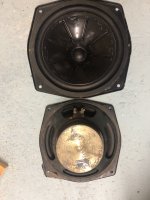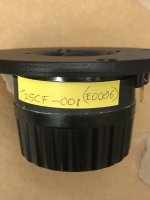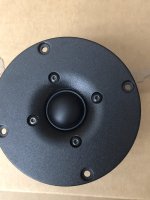That's actually a good methode to find problem spots! I actually have 2 of them hanging next to me at the wardrobe of my office 😀FWIW I bought a stethoscope for listening to panel vibrations in loudspeakers, and the isolation of my record deck. Rather than measure using instruments, actually listening to panel resonances can give an instant impression of where bracing might need to be applied.
But when you want to quantify different structures and measures to improve your build - you need to measure. And compare. And measure. And question your results. Measure again. Discard the faulty trials. And ... 🤓
It seems like a good combined option for bracing and damping. Have you seen results of % infill for damping and whether it shows the same reduction in volume?Print low % infill
Boxiness is anything that draws your ear/brain to the presence of the box in the room.
Anything, from the box panels vibrating, to internal reflections or resonances coming thru the cone, the drivers themselves, the actual design of the loudspeaker (ie XO discontinuity)…
And it doesn’t have to be a box. One of the boxiest speakers i have ever heard was an OB.
And they don’t have to be big boxes. I learned some valuable lessons from the original mFonken. It took 2 failures before we got it right. The first one was really boxy. No change in driver or alignment.



dave
Anything, from the box panels vibrating, to internal reflections or resonances coming thru the cone, the drivers themselves, the actual design of the loudspeaker (ie XO discontinuity)…
And it doesn’t have to be a box. One of the boxiest speakers i have ever heard was an OB.
And they don’t have to be big boxes. I learned some valuable lessons from the original mFonken. It took 2 failures before we got it right. The first one was really boxy. No change in driver or alignment.
dave
It seems like a good combined option for bracing and damping. Have you seen results of % infill for damping and whether it shows the same reduction in volume?
Volume infill on to-do list. Shell infill: 10% gyroid 10mm wall, 3 perimeters is rock solid.
PLA+ soft 70D, low extrusion temp
Tech PLA (brittle) high extrusion temp
if you make PLA foil then it makes noise sound like polyamide (rescue foil) so very stiff
fun begins when you use PP+GF (self damping, high stiffness, very cheap) or PLA+GF (30$/kg filament)
Little kid toys with speakers! How did you keep the fingers away from those irresistable dust caps with the fancy patterns on them?
Looking for advice on building a speaker using these units. A SEAS tweeter e0006062612-050 from an ATC 100 speaker and a couple of old IMF units - I am guessing mid/bass the cone is 18cm in dia and the overall width is 21cm. I was thinking of a small transmission line design.
Attachments
Love this last line- sound quality is not one of them. Reminds me of the new invertor compressor air-conditioners- they are sleek, nicely painted, lightweight, consume less electricity, with just a small problem that they generally cannot cool well!Nevertheless - these resonant systems also have their pro's (less excursion, less THD, more max level, higher sensitivity without EQ), but sound quality is normally not one of them.
Lol. At least my pre-alignment tables lines seemed a combination of good and bad effects. Even as I tried not to extend their design too far..
Calling more group delay ringing is a bit of a stretch.The steeper, the more ringing.
There is no ringing for Q-factor equal or lower to 1/√(2) (critical damped).
Only a bit of overshoot, but that is not defined as ringing.
Not that all of that really matters, because an higher Q-factor will just simply give more output in the frequency domain (aka a hump or boost at that frequency)
The order amount of a filter doesn't influence this (lack of) "ringing".
It does add extra group delay, since the slope is steeper.
All that being said, a transmission line has the same order as a ported system.
Therefor, falls into the same group delay category.
On the other hand, a closed system with an additional high-pass filter, will also fall into the same category.
So there is always a trade-off.
In this case this trade-off is more practical I think.
But that all depends on context.
Last edited:
I think @Boden is right though. If you look at filter tables, you'll notice for a given name such as Butterworth, its Q of 0.707 only applies to the 2nd order. A 4th order would have something like 0.54 and 1.3 cascaded, and the step and impulse responses do start to ring, even though the top of the FR plot looks perfectly flat.
What can also be deceiving is that, graphed over time the scale has to be linear, so the ringing appears to fade a lot faster than it would on a log scale.

Link: Analog Chapter8
What can also be deceiving is that, graphed over time the scale has to be linear, so the ringing appears to fade a lot faster than it would on a log scale.
Link: Analog Chapter8
I am fully aware of this.I think @Boden is right though. If you look at filter tables, you'll notice for a given name such as Butterworth, its Q of 0.707 only applies to the 2nd order. A 4th order would have something like 0.54 and 1.3 cascaded, and the step and impulse responses do start to ring, even though the top of the FR plot looks perfectly flat.
I guess it's just how to use the word "ringing", because seen from a system control perspective, nobody would call that ringing.
Just a little bit over overshoot.
Btw, the Q of 0.707 still applies to the higher order transfer functions as well.
But you're correct that it's being created by two other Q factors.
The total Q is still the same though, also because this has to satisfy the fact that for a Q of 0.707, the f0 (resonance freq) is at exactly -3dB.
This is independent of the order of the filter.
For those who think, how is this useful?
Well, thinking in those kind of systems, immediately shows that higher order systems are a lot more respectable for changes in one of the parameters, resulting sometimes in much bigger errors.
Or in other words, the higher the order and complexity, the less predictable it becomes.
Eventually this could mean that the loudspeaker won't be performing or sounding like you had in mind.
Transmission lines in particular can sometimes be a bit of trial and error.
Last edited:
7” bass driver. Bextrene with ribs? Not seen anything like it in any of the IMFs known to me. Would have to be a later one.
Does look a lot like a tweaked KEF B200.
Do you have any data?
dave
all enclosure loudspeakers suffer theoretically from the problem that the thin loudspeaker cone is the weak point in the box.
If you can hear bass coming through solid walls in houses you can imagine that 2mm of cone material cannot withstand sound coming delayed and distorted through it.
Open baffle speakers profit from being no trap for the waves.
If trapped sound is difficult to be damped - and nearly all damping materials only can damp middle tones well it is clear that some relief in pressure in the bass through a TML or reflex can help to get rid from sound pressure being enclosed in a box.
If you can hear bass coming through solid walls in houses you can imagine that 2mm of cone material cannot withstand sound coming delayed and distorted through it.
Open baffle speakers profit from being no trap for the waves.
If trapped sound is difficult to be damped - and nearly all damping materials only can damp middle tones well it is clear that some relief in pressure in the bass through a TML or reflex can help to get rid from sound pressure being enclosed in a box.
I'd disagree with the perspective there. Cabinet loading of the cone can be a good thing, as that's it's intended purpose.
Unwanted modal behaviour is more a matter of box design. It is typically addressed with damping material and cabinet shape. The greater a cabinet dimension, the more damping material can be accommodated.
Unwanted modal behaviour is more a matter of box design. It is typically addressed with damping material and cabinet shape. The greater a cabinet dimension, the more damping material can be accommodated.
Just design in such a way, both are not really needed 😉It is typically addressed with damping material and cabinet shape. The greater a cabinet dimension, the more damping material can be accommodated.
The benefit of open baffles, is the lack of non-symmetrical loading on the cone that a closed box (or any other design) has.
This difference in loading (compliance) will add additional distortion.
Although this is only 2nd order, plus at a certain point not really significant anymore I think.
But as always, ALL systems have pros and cons.
The cons of open baffle systems are obvious I think.
I do agree with you that sounds isn't hard to absorb.
If you design a cabinet well, you can bring this easily up to 600-1000Hz.
Absorption material works extremely efficient there.
Below that first standing wave inside the cabinet there is nothing to be worried about since this is in the same region as the piston range. (no reflected or "trapped" sound).
In practice you want to be roughly one to an half (maximum) octave below that first cabinet mode.
It CAN be problematic with bigger cabinets, especially ported ones.
Since you want to have a good open path towards the port.
A mass loaded TL is a better solution in those cases I believe.
A traditional TL is quite the challenge with this.
In my experience they give a very specific nostalgic sound, mostly because of some modes that are quite obvious.
Last edited:
I found in the literature about sandwich cone loudspeakers in the AES article from D A Barlow the information that the sound propagation through the cone is minimized by roughly 20db in comparison to usual paper cones.
Esa Merilainen writes:
It can be quite easily demonstrated that in a typical middle-sized hifi loudspeaker with a 6.5-inch woofer and even with comparably good damping, the magnitude of the cabinet noise penetrating the cone is in the 300 Hz region more than 10% of the directly radiated sound's magnitude. This means that the ratio of the directly radiated sound to the leaked cabinet noise is worse than 20 dB! However, by heavy and careful stuffing, this figure is possible to be improved to around 40 dB.
https://www.current-drive.info/6
Esa Merilainen writes:
It can be quite easily demonstrated that in a typical middle-sized hifi loudspeaker with a 6.5-inch woofer and even with comparably good damping, the magnitude of the cabinet noise penetrating the cone is in the 300 Hz region more than 10% of the directly radiated sound's magnitude. This means that the ratio of the directly radiated sound to the leaked cabinet noise is worse than 20 dB! However, by heavy and careful stuffing, this figure is possible to be improved to around 40 dB.
https://www.current-drive.info/6
Well, in that case, TLs could be quite beneficial since they guide or funnel the back-wave along a smooth path with less reflections along the way. A low cross-sectional area of the pipe would also limit the direct bass output, so the cone moves less.
With a conventional golden-ratio style box, strong internal reflections alternate between fighting against the cone movement, creating notches in the frequency response, and helping the cone at a range of frequencies in-between, creating peaks.
With a conventional golden-ratio style box, strong internal reflections alternate between fighting against the cone movement, creating notches in the frequency response, and helping the cone at a range of frequencies in-between, creating peaks.
Very useless statement without knowing the cabinet dimensions and showing data.I found in the literature about sandwich cone loudspeakers in the AES article from D A Barlow the information that the sound propagation through the cone is minimized by roughly 20db in comparison to usual paper cones.
Esa Merilainen writes:
It can be quite easily demonstrated that in a typical middle-sized hifi loudspeaker with a 6.5-inch woofer and even with comparably good damping, the magnitude of the cabinet noise penetrating the cone is in the 300 Hz region more than 10% of the directly radiated sound's magnitude. This means that the ratio of the directly radiated sound to the leaked cabinet noise is worse than 20 dB! However, by heavy and careful stuffing, this figure is possible to be improved to around 40 dB.
https://www.current-drive.info/6
Although he does mention tweeters.
The great thing about tweeters, is that they are much easier to measure on.
If you ever measured on a tweeter with or without damping material, you know and will see that his general statement is incorrect.
There is no backwave noise below the first standing wave of the compartiment.
You're in full piston pressure area, exactly the same thing as the room gain inside a living room, below the first room mode.
In this case the first mode of the cabinet.
Above this first mode, first standing waves take over, than (local) reflections. Exactly also like a room. Or any acoustic space/volume for that matter
You are doing useless statements, too.Very useless statement without knowing the cabinet dimensions and showing data.
As you cannot show any empirical data.
- Home
- Loudspeakers
- Multi-Way
- Transmission Line vs. Sealed enclosure



